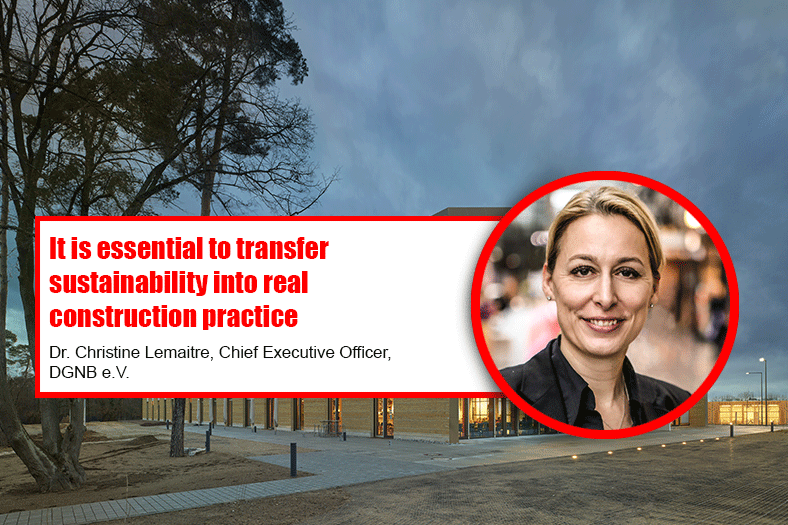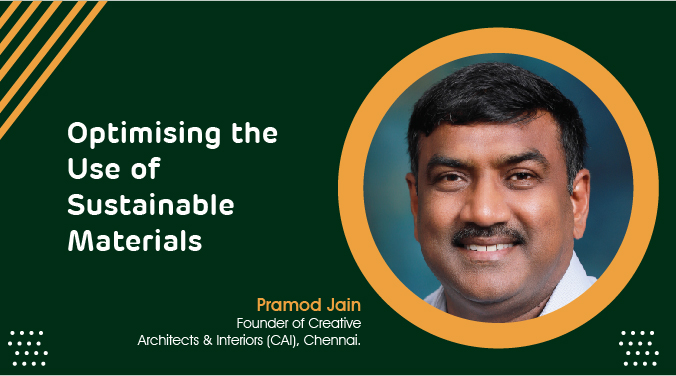It is essential to transfer sustainability into real construction practice

Dr. Christine Lemaitre Chief Executive Officer DGNB e.V. speaks to Vikas Bhadra about green buildings, sustainability and the global initiatives of DNGB for promoting climate and culturally compatible construction in countries like India.
What is your idea of green and sustainable buildings, are they one and the same?
Sustainable building, as we understand it at the DGNB German Sustainable Building Council, goes far beyond green aspects. It is about the environment, people and profitability in equal measure. The whole green movement has its origins more in the ecological field. But in our opinion this does not go far enough. We need a holistic perspective and a life cycle approach. The overarching aim is a new awareness of quality in building, which integrally encompasses aspects such as climate action, resource conservation, health and well-being, the circular economy and biodiversity. Additionally, projects have to be adapted to the specific climatic and cultural conditions and be appropriate in terms of land consumption.
As a trained civil engineer what enticed you towards the concept of green and sustainable buildings? Everyone involved in the design of the built environment bears a great responsibility: engineers as well as architects, builders and investors, local authorities and politicians. We shape our cities and have a decisive influence on people’s quality of life. Added to this is the huge influence of our buildings on the climate and the immense consumption of resources. We simply cannot afford to carry on here as we have done in the past decades. That’s why I also find it unacceptable for someone to fail to meet this obligation to build sustainably. Instead of quick, cheap solutions, we need quality, flexibility and durability. Or to put it another way: We simply have to build in the right way. To pioneer and convince others of this view has always been my motivation.
Can you cite a project, which according to you, epitomises the concept of both green and sustainable building?
A fantastic current example is the Alnatura Campus in Darmstadt, Germany. The project has received the DGNB’s highest certification level in Platinum and was awarded the German Sustainability Award Architecture last year. There are countless exciting sustainability details in the project. For example, it is Europe’s largest building with a rammed earth façade. The raw material partially comes from the construction waste of the large infrastructure project Stuttgart 21 and would otherwise have ended up in the landfill. Additionally, you can easily experience that the building has been made for people. Thanks to its outstanding architectural design with plenty of daylight and open floor plans, it offers employees a very good quality of stay. A great example that shows what is possible when creative drive, courage and stamina of the client and planners come together.
Prior to the pandemic, climate change, as also now continues to remain a challenge, what role can the green and sustainable buildings play in mitigating the crisis? We all know about the central importance of the building sector for climate action as it is one of the main emitters of CO2. The idea of sustainable building is the precise answer when you aim for the reduction of carbon emissions in the planning, construction and operation of buildings. Using methods such as LCA and LCC, it provides the necessary basis for making the right decisions for a project. In this respect, sustainable construction is an essential prerequisite for buildings to become climate positive. Ultimately, the main thing here is to get started. Only if we finally start doing this properly and on a large scale we can achieve the necessary effects sufficiently and quickly.
In the post pandemic world do you feel the green and sustainable buildings and technologies will have a major say in the built environment?
Clearly, yes. After all, we have been shown how important a high-quality built environment is. What value buildings have for our health and quality of life. Perhaps the pandemic will even have a positive, accelerating effect on the built environment. But there is something else that is important to me: we should stop asking over and over again what is after Co-vid 19. Because then we would continue to wait and see instead of taking action. It is a life with the pandemic that we must be able to shape. Should we actually succeed at some point in getting the whole thing completely under control, we will still benefit from everything we initiate now in terms of quality of life.
How can green buildings aid health and wellbeing unlike the regular buildings?
The DGNB certification of sustainable buildings addresses the relevant aspects by means of various criteria. Not separately, but integrally. In concrete terms, the positive result of a measurement of the indoor air quality is a minimum requirement for obtaining the DGNB certificate. The avoidance of harmful and hazardous substances is of central importance. This ultimately applies to all materials used. In addition, there are numerous other issues that have a direct impact on the wellbeing of building users. These include a high level of acoustic comfort or the availability of daylight. Thermal comfort is also important. Here we must not fall into the trap of chasing after false comfort requirements and artificially cooling down buildings with massive energy input. After all, sustainable construction is about striking the right balance between various sustainability goals.
How can the process of constructing the project itself be made green and sustainable?
Here, the following applies: Those who adhere to the three essential principles of environment, economy and social and find the right balance are already doing many things right. The detailed requirements are specified in the corresponding certification criteria. The construction site and the construction process itself are also addressed as a criterion within the DGNB certification. Moreover, we are currently in the process of developing our own form of certification specifically for this topic. The focus will be on occupational health and safety aspects as well as the reduction of noise and dust and the recycling of construction waste according to its type. We have recently published our own certification for the dismantling of buildings, which is also an important part of this. This new certification covers the protection of existing buildings, climate action and the circular economy in equal measure.
Once the project is complete, how can the green credentials be retained post occupancy of the building?
This step is a very decisive one. Because it simply takes a certain amount of time for a building and its consumption levels to be set correctly – even for those that are planned and built sustainably. One key is certification. Even when certifying a new building or a renovation, there are a number of criteria that help to increase process quality. Basically, certification provides a client with an as-built model of his building. After commissioning, other aspects and also other actors come into focus. In other words the user himself, the operator and the owner. At the DGNB we have our own certification system for buildings in use, which systematically helps to guide buildings in operations towards climate neutrality.
What are some of the chief materials which play a dominant role in the realisation of green and sustainable buildings in the contemporary age? Will local and natural materials have a say?
Local availability is an essential factor for the sustainability of a material. After all, the entire life cycle assessment is at stake. And that also includes the carbon emissions that occur during production and transport. The ease of recovery and recycling is also decisive. One basic rule is that you always have to consider the context of the project. Not all materials are suitable for all kind of building schemes and requirements. For this reason, the most important thing is to take a close look, to create variants, which is best in terms of the overall sustainability quality.
Does it mean going green always has to be expensive or is it a farce, can you validate the argument? It is a persistent prejudice that lacks foundation. The question is, after all, what is sustainable building actually compared to? With a quick and cheap way of construction, so that a building has to be demolished again after a few years? The actual additional costs also tend to come from many other additional requests that are added in the course of the project and then attributed to sustainability. The question of costs is a very central one, because it is always put first. But the way in which costs are discussed is extremely brief. And here we are not even talking about short payback periods due to energy-efficient construction and lower operating costs. The plus in productivity, less sick leave and other wellbeing aspects makes the discussion about additional costs even more absurd.
What is DGNB’ role in promoting awareness about green and sustainable buildings?
The DGNB is a non-profit organization with more than 1200 member organizations from all sectors of the construction and real estate industry. This makes us Europe’s largest network for sustainable building. Our overriding goal is to transform the sector towards a comprehensive and ambitious understanding of quality. The principle of certification is essential for us to transfer sustainability into real construction practice. By means of the criteria formulated therein, a common understanding of the concrete requirements is created for all those involved in construction.
In a sense, a common knowledge base that would otherwise not exist. We are not only active in Germany and Europe. We have certified projects in around 30 countries worldwide, trained experts in sustainable construction in over 40 countries and maintain a network with partners around the world. This also includes initiatives such as Building Sense Now, in which we promote climate- and culturally compatible construction in countries like India.
Cookie Consent
We use cookies to personalize your experience. By continuing to visit this website you agree to our Terms & Conditions, Privacy Policy and Cookie Policy.









